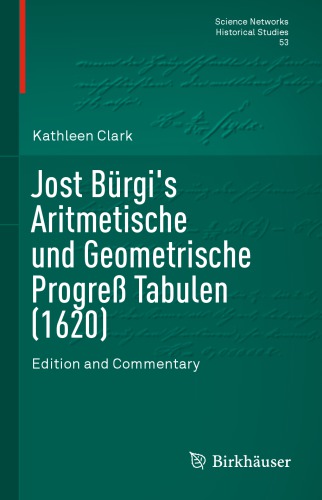

Most ebook files are in PDF format, so you can easily read them using various software such as Foxit Reader or directly on the Google Chrome browser.
Some ebook files are released by publishers in other formats such as .awz, .mobi, .epub, .fb2, etc. You may need to install specific software to read these formats on mobile/PC, such as Calibre.
Please read the tutorial at this link: https://ebookbell.com/faq
We offer FREE conversion to the popular formats you request; however, this may take some time. Therefore, right after payment, please email us, and we will try to provide the service as quickly as possible.
For some exceptional file formats or broken links (if any), please refrain from opening any disputes. Instead, email us first, and we will try to assist within a maximum of 6 hours.
EbookBell Team

0.0
0 reviewsThis monograph presents a groundbreaking scholarly treatment of the German mathematician Jost Bürgi’s original work on logarithms, Arithmetische und Geometrische Progreß Tabulen. It provides the first-ever English translation of Bürgi’s text and illuminates his role in the development of the conception of logarithms, for which John Napier is traditionally given priority. High-resolution scans of each page of the his handwritten text are reproduced for the reader and as a means of preserving an important work for which there are very few surviving copies.
The book begins with a brief biography of Bürgi to familiarize readers with his life and work, as well as to offer an historical context in which to explore his contributions. The second chapter then describes the extant copies of the Arithmetische und Geometrische Progreß Tabulen, with a detailed description of the copy that is the focus of this book, the 1620 “Graz manuscript”. A complete facsimile of the text is included in the next chapter, along with a corresponding transcription and an English translation; a transcription of a second version of the manuscript (the “Gdansk manuscript”) is included alongside that of the Graz edition so that readers can easily and closely examine the differences between the two. The final chapter considers two important questions about Bürgi’s work, such as who was the copyist of the Graz manuscript and what the relationship is between the Graz and Gdansk versions. Appendices are also included that contain a timeline of Bürgi’s life, the underlying concept of Napier’s construction of logarithms, and scans of all 58 sheets of the tables from Bürgi’s text.
Anyone with an appreciation for the history of mathematics will find this book to be an insightful and interesting look at an important and often overlooked work. It will also be a valuable resource for undergraduates taking courses in the history of mathematics, researchers of the history of mathematics, and professors of mathematics education who wish to incorporate historical context into their teaching.